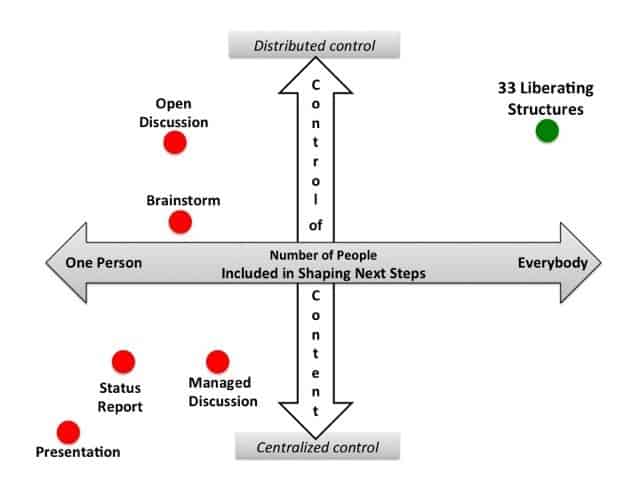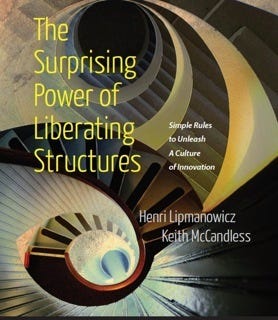
In June, I had the pleasure of meeting Anna Jackson, of Alpinista Consulting and she introduced me to Liberating Structures. I’m always seeking new ways to compliment and enhance my skills and it was immediately clear to me that Liberating Structures would be applicable to my innovation workshops and potentially more. Luckily, Anna was facilitating a Liberating Structures workshop in 6 weeks and my schedule allowed me to attend. Also, she generously agreed to meet with me prior to the seminar to give me an overview of the process.
Liberating Structures is a framework created by Henri Lipmanowicz and Keith McCandless, intended to provide simple rules that make it easy to include and unleash everyone in shaping your future. The framework consists of a collection of 33 structures or methods that introduce tiny shifts in the protocols of how we meet, plan, decide, learn, and relate to each other. They put the innovative power once reserved for experts only, into the hands of everyone.

“Liberating Structures are participatory methods that disrupt conventional patterns in how we work together. One Liberating Structure changes a meeting; the repertoire can change an organization.”
Most organizations rely on what Henri and Keith refer to as conventional microstructures. These microstructures are structures we default to when meeting and organizing into groups. Examples of conventional microstructures include open discussion, brainstorm, status reports, managed discussion, and presentations. Every time you are having a conversation or a meeting you are using microstructures.
Conventional microstructures are limited in the number of participants and the control is isolated to one individual or a select few. As a result, these conventional structures routinely work together to stifle inclusion and engagement. Liberating Structures provides more effective alternatives to our conventional structures by including everybody regardless of group size and distributing the control of content among all participants.

Five elements define the underlying design of all microstructures — conventional or liberating. Henri and Keith call them design elements because you can make choices about them based on what you want to accomplish. The five design elements and how they are implemented for a conventional presentation are illustrated below:
- Make an invitation: listen to me (the presenter)
- Distribute participation & roles: nearly 100% of total time for presenter
- Configure Groups: one listener group, one presenter
- Arrange Space and Materials: rows facing presenter and slides
- Sequence and Allocate Time: presentation followed by some Q&A
The Invitation
While participating in Anna’s workshop, I gained a deeper respect for the power of a well-crafted invitation. Invitations provide the necessary context for participants to fully engage and must be linked to tangible activities, local reality, or practical purpose. This allows participants to understand how they relate to the problem and why this is important the them. Invitations should be loving, provocative, and ambiguous in a way that each person brings their own meaning to the party. When in doubt, ask the group if the invitation is clear to them.

Which structure(s) should I use?
It is somewhat daunting to stare at the list of 33 structures. Each of the structures are effective in different situations and it’s difficult to know how to dive in. If you are struggling with which structure to use, consider referencing the LS Matchmaker. It is important to keep in mind that all of these structures are more effective than conventional microstructures so experiment and see what happens.
Below I’ve included some of the structures that I was able to personally use at Anna’s workshop and have subsequently put into action. These are some of my current favorites and I’m still exploring the full repertoire so I’m sure I’ll develop new favorites over time.
1–2–4-All (12 mins)
This simple and elegant structure complements other structures and is easy to integrate into existing meetings and workshops. It is often paired with other structures; we actually used it many times throughout the course of the workshop I attended. I was impressed at how easy 1–2–4-All allows you to to quickly include everyone regardless of how large the group. I noticed that we were able to generate great ideas much quicker than conventional methods and since participants owned the ideas, follow-up and implementation was guaranteed.
The sequence is: 1 minute silent self-reflection by individuals on a shared challenge, framed as a question , 2 min generating ideas in pairs, building on ideas from self-reflection. 4 min sharing and developing ideas in a group of 4, 5 min reflecting with the entire group, prompt them with invitations like: “What is one idea that stood out in your conversation?”
Impromptu Networking (20 mins)
This is a personal favorite and I’ve found myself using it often. In fact, I used it just last week at the beginning of my talk a Product Camp, as I needed a way to boost the energy in the room. It is especially useful when the energy in the room is lagging or people in the group don’t know each other very well.
The sequence is: Organize the group into pairs. Then, have each pair rapidly answer a question you provide them (the invitation). This is repeated for a total of three rounds, so it’s a good way to warm up, get to know people, and help people set an intention for their participation.
TRIZ (35 mins)
This structure clears space for innovation by providing the group a safe environment to be vulnerable and let go of what they know (but rarely admit) limits their success. It does this by inviting creative destruction. It’s great at helping stagnant teams discover nascent opportunities for improvement, while also empowering teams that have been wanting change. I enjoyed how outrageous some of the ideas became and found it amusing that often the most outrageous ideas resembled things we needed to stop doing and until now haven’t been willing to admit.
The sequence is: Spend 5 min selecting a most unwanted result, 10 min 1–2–4-All making a list of things to do to ensure the unwanted result, 10 min 1–2–4-All making a list of things they are currently doing that resemble items on the first list, 10 min 1–2–4-All making a list of things they can do to address items on the second list.

Troika Consulting (15 mins per person)
This structure helps participants gain insight on a challenge they decide to share and unleashes local wisdom for addressing that challenge. During the workshop, I was a consultant and my client was curious to learn how he might better manage his time. The other consultant and I took vastly different directions, which led to interesting dialog, all the while the client was silently learning through eavesdropping and not influencing our conversation. This is a simple and effective way to extend coaching support for individuals beyond formal reporting relationships.
The sequence is: Organize into groups of 3, 1 min participants to reflect on the challenge and the help needed, 1–2 min groups have the first client share his or her challenge, 1-2 min consultants ask the client clarifying questions, 4–5 min client turns around with his or her back facing consultants and together, the consultants generate ideas, suggestions, coaching advice, 1–2 min client turns around and shares what was most valuable about the experience, switch to next client and repeat.
25/10 Crowdsourcing (30 mins)
This is one of my favorite structures and I’ve used it previously, with Fusebox Festival, without realizing it was a part of Liberating Structures. In fact, several of the Design Sprint exercises, including the How Might We voting, bear strong resemblances. If you, like me, are frustrated by conventional brainstorming that generates ideas that go nowhere, this structure is a rapid way to share and vote on potential ideas and tap into the wisdom of the crowd.

The Sequence is: 3 min explain the process, 2 min demonstrate how to exchange the cards and write record your vote, 5 min each participant writes down a bold idea and first step, 3 min pass the cards around, when bell rings stop, read the card, flip over and score it 1–5, repeat 4 more times for a total of 5 scores, participants add up all scores, write the number on the front of the card, circle it, then hold it up. Find the best scoring ideas and discuss with the entire group.
Anna’s 3-day workshop is broken up into 2 sessions. I’m looking forward to attending the 3rd day which is scheduled for mid-September. I’m curious to hear how others have begun to adopt the Liberating Structures and to share my experiences as well.
Getting Started
Instructions for using Liberating Structures are on the website , book, and mobile app. The website has lots of information. If you are wanting to learn more about the structures, I suggest going straight to the LS Menu and start to read about each structure in the menu. A tip to quickly digest each structure is to begin with the purpose at the top and then skip to step 5 and read the sequence and allocation to get an overview of how the structure functions.

If you are in the central Texas area, Anna runs a Central TX Liberating Structures Meetup. I encourage you to join and attend.





